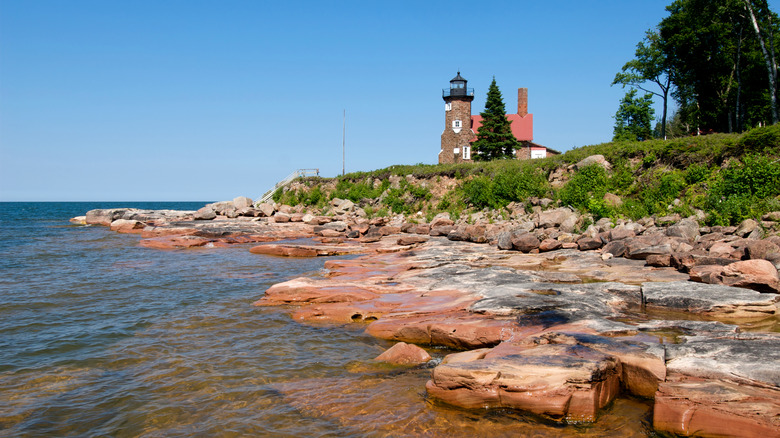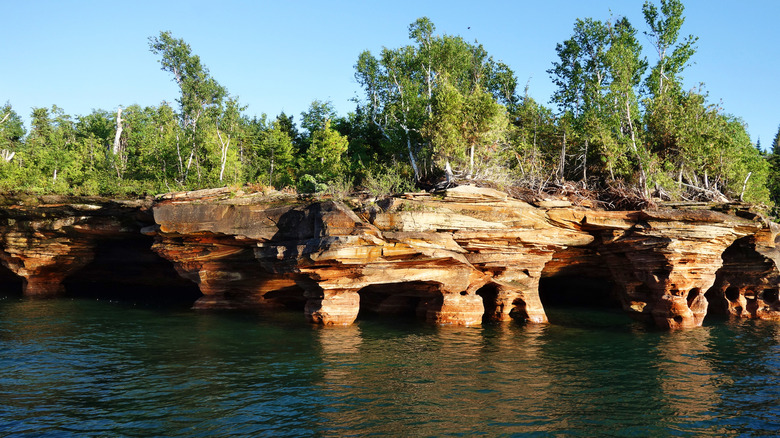Wisconsin's Wildly Underrated Island Has Sandy Beaches, Enchanting Sea Caves, And Lush Forest
Not many people plan explorations around, or even know of, the magical archipelago just off the coast of Wisconsin. Made up of 22 islands, the Apostle Islands are easily the most majestic floating delights in the Midwest. And they come with a mystical origin story to match: according to Chippewa legend, a Manitou (spirit), failing to catch a stag it was chasing, angrily threw rocks at it. Eventually, those rocks, landing in the lake, formed the rugged outline of the Apostle Islands. Whether you are attracted by the archipelago's legendary mystique or simply fascinated by its natural delights, you can satisfy your curiosity by visiting one of Wisconsin's wildly underrated islands: Sand Island.
Waabaabikaa-minis (Sand Island's native name, meaning "lots of white rocks island")is the most westerly of the Apostle Islands, with its muzzle facing the village of Sand Bay on mainland Wisconsin. If you are driving from the mainland, Sand Bay is about 80 miles from Minnesota's idyllic, scenic byway city of Duluth. Far away from the urban hustle and bustle, the remote island of Sand Island has miles of golden beaches, its own Victorian lighthouse, and enchanting sea caves and unspoiled stretches of forest to relax in.
Remoteness is undoubtedly one of the islands' most beloved features, so you can expect the journey to reach your final destination to be tricky. From the mainland, you can reach Sand Island with your own boat or kayak for maximum freedom. Alternatively, you can board the Apostle Islands Cruise lines operating a shuttle service, or take a water taxi operated by private charters. Bear in mind that, exception made for Madeline Island, no cars are allowed in this National State Park area.
Explore the natural delights of Sand Island
Towering above the tiny island, the Sand Island lighthouse is arguably the most picturesque of the handful of lighthouses on the Apostle Islands. The Gothic-inspired, Victorian structure has witnessed well over a century of history since its construction in 1881, including the comings and goings of its settling Norwegian immigrant population, which at one point reached the 100 permanent residents mark. The island has gone back to its original wilderness since that milestone in 1918, offering little more in the way of architecture to admire, but an abundance of unspoiled natural grounds and breathtaking sea caves to explore.
Hiking is a popular pastime in the Apostle Islands, with over 50 miles of well-maintained trails catering to all types of experience. There are two main trails on Sand Island: the 2-mile Lighthouse Trail, starting from the eastern shore and ending at the historic lighthouse, and the shorter Wellisch Cabin Trail following the old road and going past the two campsites on the island. You can orient yourself with a handy, digital trail map you can download on your phone or print to take with you.
Sand Island is also a popular spot for camping, with about six main campsites on the eastern shore. If you are planning to camp during summertime, it's worth keeping in mind that temperatures won't go above 80 degrees Fahrenheit, and are generally in the cooler 60 degrees Fahrenheit zone. In winter, Sand Island can get as cold as 10 degrees Fahrenheit, so make sure to pack warm layers if visiting during the colder, windier months.
Marvel at the enchanting sea caves of Sand Island
Another excellent way to explore the island is by opting for a paddle trail. About 15 miles fully on the water is all it takes to circumnavigate this jewel in the middle of Lake Superior, starting from Sand Bay on the mainland and gliding parallel to the island's "horn," the small peninsula where its famous sea caves dwell. There is no denying that the Midwestern states with access to the Great Lakes come with a degree of waterside natural enchantment that is hard to match. Deep in the wilderness of neighboring state Michigan, the hidden jewel of Isle Royale National Park captures a similar beauty as the Apostle Islands, with adventure, remoteness, and rugged wilderness drawing only a few adventurers in the know.
The Apostle Islands have their craggy and crystalline caves to set them apart from their Michiganian neighbor across Lake Superior. The product of millennia-old geological changes, these caves are the result of ice ages, thawing periods, and the subsequent contemporary freezing over of the lake during winter. You can get closer to the arches and characteristically copper-red limestone chambers that make these caves unique by approaching with your kayak, or joining a boat tour during hot and mild weather months. In order to ensure a safe visit, boaters and kayakers are encouraged to only get closer in stable weather conditions and to always check current weather conditions.
For winter lovers who were hoping to cross the ice over Lake Superior, unfortunately, walking to the ice caves has not been possible since 2015 due to ice levels and stability, making the chances of seeing ice caves extremely rare.


